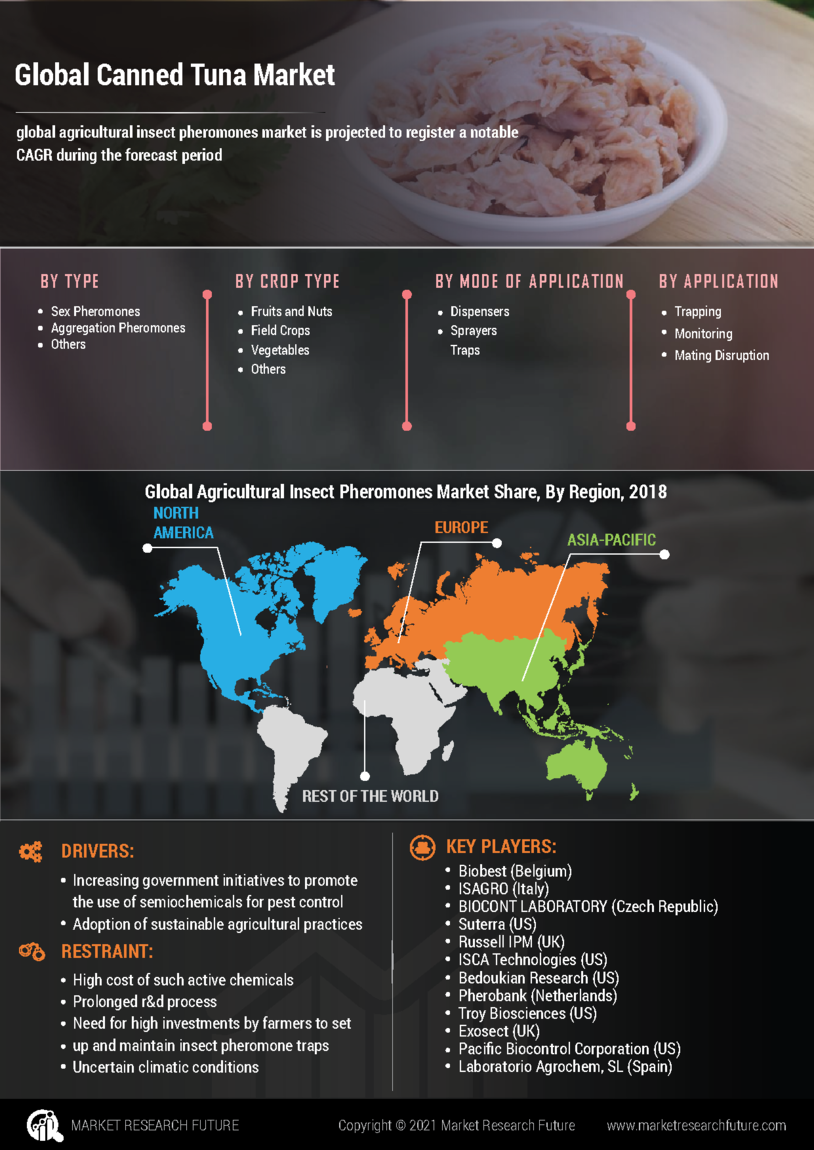Global Canned Tuna Market Overview
Canned Tuna Market Size was valued at USD 915.00 million in 2021. The Canned Tuna market industry is projected to grow from 2021 to USD 15,103.07 million by 2030, exhibiting a compound annual growth rate (CAGR) of 4.15% during the forecast period (2022 - 2030). Canned tuna has gained popularity in recent years due to its high nutritional value and ease of use. Tuna is a lean fish that is high in protein, omega-3 fatty acids, vitamins, and minerals. It is also low in fat and calories, making it a popular food for those looking to maintain a healthy diet. Also, most of these canned tunas are a mix of albacore or yellowfin and skipjack tuna. It accounts for a large part of the global market. Canned Tuna is a well-known seafood product and a popular ingredient in many dishes worldwide. It is a convenient and affordable source of protein that can be used in various recipes, making it a staple in many households. In recent years, the popularity of e-commerce has grown rapidly, and Canned Tuna has taken advantage of this trend. As a result, Canned Tuna has become a rising e-commerce firm, with many companies selling their products online. This has made it easier for customers to access the product, irrespective of their location.
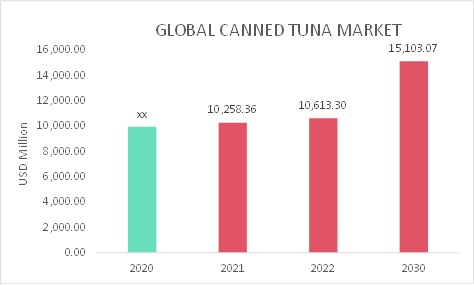
Source: Secondary Research, Primary Research, MRFR Database and Analyst Review
Canned Tuna Market Trends
- Growing Incorporation of High-Nutritious Food In Daily Diet
Canned tuna has gained popularity in recent years due to its high nutritional value and ease of use. Tuna is a low-fat fish that contains a lot of protein, omega-3 fatty acids, vitamins, and minerals. It is also low in fat and calories, making it a popular food for those who want to maintain a healthy diet. One of the main reasons to include canned tuna in your daily diet is its convenience. Canned tuna is readily available, easy to prepare, and has a longer shelf life. It can be added to sandwiches, salads, pasta, and other dishes, making it a versatile ingredient. Plus, canned tuna is an inexpensive source of high-quality protein, making it a great budget option. It is also an ideal food for a person who needs quick and easy nutrition. Canned tuna is becoming increasingly popular in tuna sandwiches and relishes, increasing the demand for this product. Also, most of these canned tunas are a mix of albacore or yellowfin and skipjack tuna. They are a cheap product consisting of a small amount of yellowfin tuna and a significant proportion of tuna. It accounts for a large part of the global market.
Additionally, canned tuna is an environmentally friendly choice because it is a sustainable source of fish and shellfish. Most tuna factories now use pole fishing methods to reduce bycatch and ensure sustainable fishing practices. In short, it can be said that the increasing inclusion of canned tuna in the daily diet is due to its high nutritional value, convenience, affordability, and environmental friendliness. As the demand for healthy and sustainable food options increases, canned tuna is likely to continue to be a popular choice for consumers in the future.
Canned Tuna Type Insights
The Canned Tuna Market segmentation, based on type, includes skipjack tuna, yellowfin tuna, albacore tuna, and others. The skipjack tuna segment accounted for the largest market share of 54.0% in 2021 and is likely to register a CAGR of 4.17% during the projected period. Skipjack canned tuna held the largest share in 2019. This species is easily available in the market with a rich and nutritious seafood experience. According to the data provided by Fish20.org, Skipjack comprises around 58.0% of the total tuna catch and most of them go for canning. According to the statistics provided by the Centre for the Promotion of Imports, 75.0% of the canned tuna imported into Europe consists of skipjack species. The Skipjack segment achieved the highest market revenue in 2021. Stingray is a salty fish that is rich in oil and is an excellent source of essential proteins, minerals, fatty acids, and fat-soluble vitamins such as vitamins A, D, and E. Calories in Skipjack. is moderate; 100g contains 103 calories and 22g/100g (39% RDI) of protein. Its dark pink flesh is firm and contains large amounts of all the essential amino acids. Polyunsaturated fatty acids are abundant in their lean muscle. Research shows that a diet rich in seafood rich in omega-3 fatty acids, such as canned tuna, can help prevent or delay cognitive decline, dementia, depression, neuropsychiatric disorders, asthma, and inflammatory diseases. In addition, bonito meat contains only 0.144 ppm of mercury, and the FDA classifies bonito meat as the best choice for mercury.
Figure 1: Canned Tuna Market, by Type, 2021 & 2030 (USD Million)
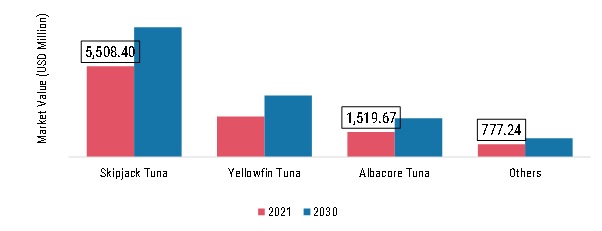
Source: Secondary Research, Primary Research, MRFR Database and Analyst Review
Canned Tuna Distribution Channel Insights
The Canned Tuna Market segmentation, based on distribution channel, includes store-based and non-store-based. The store-based segment accounted for the largest market share of 81.2% in 2021. In terms of store-based retail sales of canned tuna, supermarkets, and hypermarkets are the primary sales channels. These major retailers offer a wide variety of canned tuna brands and products, providing consumers with a one-stop shop for all their grocery needs. Supermarkets and hypermarkets offer competitive prices for canned tuna. On the other hand, canned tuna is also sold in stores, but less than in supermarkets and supermarkets. Convenience stores often have limited shelf space, making it difficult for them to offer a wide variety of canned tuna. However, convenience stores often offer smaller, single-serve tuna containers that are convenient for consumers who are on the go or looking for a quick snack. In general, supermarkets and hypermarkets are the most important sales channels for canned tuna in store-based retail. Convenience stores offer a limited selection of canned tuna but can serve consumers who want smaller sizes and more convenient packaging.
Figure 1: Canned Tuna Market, by Distribution Channel, 2021 & 2030 (USD Million)
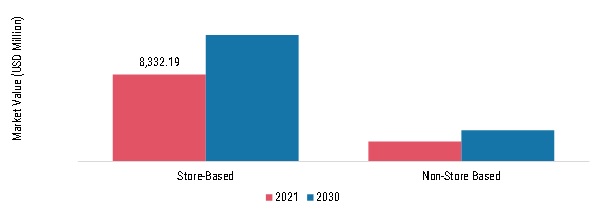
Source: Secondary Research, Primary Research, MRFR Database and Analyst Review
Canned Tuna Regional Insights
By Region, the study segments the market into North America, Europe, Asia Pacific, and the Rest of the World. The Europe Canned Tuna market accounts for the largest market share 38.0% in 2021 and is expected to exhibit a 4.15% CAGR due to the growing demand from the millennial population. Europe is expected to maintain the second-largest canned tuna market share. This is due to the growing demand of the millennial population. The increase in the number of working women and busy lifestyles has led to a decrease in time spent cooking. This has made them depend on various convenience foods as it saves time and also fulfill all nutritional needs. In the United States, consumers are influenced by Japan and India. The main markets for tuna consumption in the region are Spain, Italy, France, and Portugal. According to a study by the European Fisheries and Aquaculture Market Observatory (EUMOFA), tuna is the most consumed fish in the region. Further, the Spain Canned Tuna market held the largest market share, and the France Canned Tuna market was the fastest-growing market in the region.
Further, the major countries studied are U.S., Canada, Mexico, Germany, UK, Italy, Spain, France China, Japan, India, Australia & New Zealand, and the Rest of the World.
Figure 3: CANNED TUNA MARKET SHARE BY REGION 2021 (%)
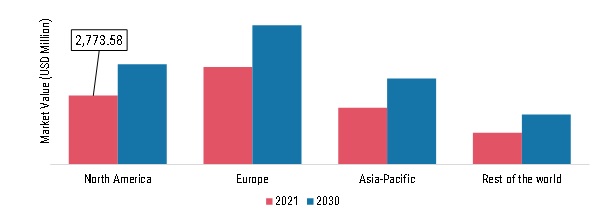
Source: Secondary Research, Primary Research, MRFR Database and Analyst Review
The European canned Tuna market stands as a dynamic and evolving sector, Europe is expected to hold the second-largest canned tuna market share in the market. This is due to the growing demand of the millennial population. The increase in the number of working women and the busy lifestyle has led to a decrease in the time spent on cooking. This has made them depend on various convenience foods as it saves time and also fulfill all nutritional needs. In the United States, consumers are influenced by Japan and India. The main markets for tuna consumption in the region are Spain, Italy, France, and Portugal. According to a study by the European Fisheries and Aquaculture Market Observatory (EUMOFA), tuna is the most consumed fish in the region. Tuna consumption per person was 2.78 kilograms in 2018, of which the largest part was 11% of all fisheries and aquaculture products. However, due to the global COVID-19 pandemic, tuna consumption has decreased, and Spain and Italy are the most affected countries in the region. The increase in the number of patients in the area led to the closure of malls and shops. This reduced market sales in the area and thus negatively affected the market. Italian canned tuna is one of the best-selling seafood in the United States, increasing its demand in the industry. Several industrial brands produce unique product series in Italy, such as Ventresca Yellowfin Tuna by Angelo Parodi with a buttery taste of yellowfin tuna in oil, Callipo Italian Canned Tuna with firm textured meat, Tonnino Tuna Filet offers light canned tuna with tuna fillet. spring water that is perfect for salads. The European canned tuna market covered Germany, the United Kingdom, France, Italy, Spain, and the Rest of Europe, of which Spain emerged as the leader with a 28% market share in 2021.
The Asia-Pacific Canned Tuna market is expected to grow at a CAGR of 4.84% from 2021 to 2030. The region's millennial population and a growing penchant for ready meals have contributed to the strengthening of the regional market. Rapid urbanization and the adoption of Western lifestyles have increased market demand. Consumers today widely use canned tuna for cooking because of its convenience and longer shelf life. This has further fueled the market growth. The Asia Pacific canned tuna market is projected to witness significant growth over the forecast period (2021-2026) due to the increasing demand for convenient and healthy food products. Canned tuna is a rich source of protein, omega-3 fatty acids, and essential vitamins and minerals, which makes it an ideal choice for health-conscious consumers. In addition, the growing urbanization and busy lifestyle of consumers in the Asia Pacific region have led to an increase in the consumption of ready-to-eat food products, which is expected to drive the demand for canned tuna in the region. The rising popularity of various tuna-based dishes, such as sushi and sashimi, is also contributing to the growth of the market. Moreover, the increasing number of supermarkets, hypermarkets, and convenience stores in the region is making canned tuna easily available to consumers. This, in turn, is expected to boost the sales of canned tuna in the coming years.
The North American canned Tuna market is a dynamic and growing sector, especially the United States, holds the highest position in the North American canned Tuna market due to its strong food and beverage industry, developed pharmaceutical sector, and high demand for natural and organic products. The North America region and the emphasis on cleanly produced ingredients, as well as the transition to a healthier and more natural additive, have greatly increased the demand for Canned Tuna, known for its versatility and natural origin. North America is home to some of the world's largest food and beverage manufacturers, who are constantly innovating and expanding their Canned Tuna product lines to improve the quality and stability of their offerings. Moreover, the US Canned Tuna market held the largest market share, and the Canada Canned Tuna market was the fastest-growing market in the region.
In the Rest of the World, including regions such as Africa, the Middle East, and South America, new untapped markets, including Saudi Arabia and Egypt, are emerging as major marketplaces with immense growth opportunities. According to the statistics provided by the ‘GLOBEFISH’, Saudi Arabia has witnessed a surge of 23.3% and Egypt witnessed a surge of 15.0% in 2019 for the canned and processed tuna import as compared to the previous year. Canned tuna from South America, the Middle East, and Africa make up a significant part of the global canned tuna industry. The demand for canned tuna in these regions is driven by factors such as population growth, changing eating habits, and increasing health awareness. In South America, Brazil and Ecuador are the largest producers of canned tuna, with Brazil being the largest market for canned tuna consumption. The demand for canned tuna in Brazil is expected to grow due to the rising health consciousness among consumers and the increasing popularity of ready-to-eat products.
In the Middle East, countries such as Saudi Arabia, Iran, and the United Arab Emirates are major consumers of canned tuna. The demand for canned tuna in the region is driven by factors such as a growing population, increasing urbanization, and the need for convenient and affordable sources of protein. In Africa, countries such as Ghana, Senegal, and Côte d'Ivoire are emerging markets for canned tuna consumption. The demand for canned tuna in these countries is driven by increasing health awareness and the availability of affordable canned tuna products.
Canned Tuna Key Market Players & Competitive Insights
Global Canned Tuna is profitable for existing players as well as new entrants. The market is very competitive and all players are competing for more market share. Fierce competition, rapid development of canned tuna technology, and regulations are the major factors hindering the growth of the market. Considerable competition between producers can be observed in the market. Our analysis revealed that market players have adopted various strategies and innovative R&D techniques to expand their business and secure their position in the Canned Tuna Market. In recent years, the strategic moves of large players have been supports that have been used as entry strategies and as a means to reduce competition. The key players profiled in the global Canned Tuna analysis are Thai Union Group PCL, Bolton Foods, Grupo Calvo, Ocean Brands, American Tuna Inc., Aneka Tuna Indonesia, Wild Planet Foods Inc., Sea Value PLC, and many more. The industry is characterized by the existence of several small-scale producers with outdated production techniques and limited capacity, especially in developing countries such as India, which has given a significant advantage to new industry players with better processing technology.
Key Companies in the Canned Tuna market include.
- Bolton Foods (Italy)
- Thai Union Group Public Company Limited (Thailand)
- Grupo Calvo (Spain)
- Ocean Brands (Canada)
- American Tuna Inc. (United States)
- Aneka Tuna Indonesia (ATI) (Indonesia)
- Wild Planet Foods Inc. (United States)
- Sea Value PLC (Thailand)
- Frinsa del Noroeste S.A. (Spain)
- Bumble Bee Foods LLC (United States)
- Simplot Australia Pty Ltd (Australia)
Canned Tuna Industry Developments
August 2022: Thai Union and Chicken of the Sea Frozen Foods announce a partnership with North America's leading plant-based seafood, The ISH Food Company. It has a trademarked Whole System Approach to developing innovative plant-based foods. It considers every step - from soil and water to table - and asks how it can be healthier for everyone involved.
January 2022: Gruppo Calvo's Italian canned fish brand Nostromo has introduced new packaging using Real Peel technology. The 'Apri gira facile' tuna container has no inner rim, so the tuna can be poured directly onto the plate without a fork, eliminating product waste.
Canned Tuna Market Segmentation:
Global Canned Tuna Type Outlook
- Skipjack Tuna
- Yellowfin Tuna
- Albacore Tuna
- Others
Global Canned Tuna Distribution Channel Outlook
- Store-Based
- Non-Store-Based
Canned Tuna Regional Outlook
- North America
- Europe
- Germany
- France
- Italy
- Spain
- UK
- Rest of Europe
- Asia-Pacific
- China
- Japan
- India
- Australia & New Zealand
- Rest of Asia-Pacific
- Rest of the World
- South America
- Middle East
- Africa
|
Report Attribute/Metric
|
Details
|
|
Market Size 2021
|
USD 10,258.36 million
|
|
Market Size 2030
|
USD 15,103.07 million
|
|
Compound Annual Growth Rate (CAGR)
|
4.15% (2022-2030)
|
|
Base Year
|
2020
|
|
Forecast Period
|
2022-2030
|
|
Historical Data
|
2018 & 2019
|
|
Forecast Units
|
Value (USD Million)
|
|
Report Coverage
|
Revenue Forecast, Competitive Landscape, Growth Factors, and Trends
|
|
Segments Covered
|
Type, Distribution Channel, and Region.
|
|
Geographies Covered
|
North America, Europe, Asia Pacific, and Rest of the World
|
|
Countries Covered
|
The U.S, Canada, Mexico, Germany, the UK, Italy, Spain, France China, Japan, India, Australia & New Zealand, and the Rest of the World
|
|
Key Companies Profiled
|
Bolton Foods (Italy), Thai Union Group Public Company Limited (Thailand), Grupo Calvo (Spain), Ocean Brands (Canada), American Tuna Inc. (United States), Aneka Tuna Indonesia (ATI) (Indonesia), Wild Planet Foods Inc. (United States), Sea Value PLC (Thailand), Frinsa del Noroeste S.A. (Spain), Bumble Bee Foods LLC (United States), Simplot Australia Pty Ltd (Australia), among others.
|
|
Key Market Opportunities
|
· Technological Advancements
|
|
Key Market Dynamics
|
· Growing Incorporation Of High-Nutritious Food In Daily Diet
· Rising E-Commerce Firm
|
Canned Tuna Market Highlights:
Frequently Asked Questions (FAQ) :
The Canned Tuna market accounted for USD 10,258.36 million.
Increasing demand for healthy and convenient food options
The growth rate of the Canned Tuna market is 4.15% CAGR.
Europe region held the largest market share in the Canned Tuna market.
Bolton Foods (Italy), Thai Union Group Public Company Limited (Thailand), Grupo Calvo (Spain), Ocean Brands (Canada), American Tuna Inc. (United States), Aneka Tuna Indonesia (ATI) (Indonesia), Wild Planet Foods Inc. (United States), Sea Value PLC (Thailand), Frinsa del Noroeste S.A. (Spain), Bumble Bee Foods LLC (United States), Simplot Australia Pty Ltd (Australia), among others are the key players in the Canned Tuna market.
Trade policies, such as tariffs and trade agreements between tuna-producing countries and importing nations, significantly reduce the cost and availability of canned tuna in different markets.










